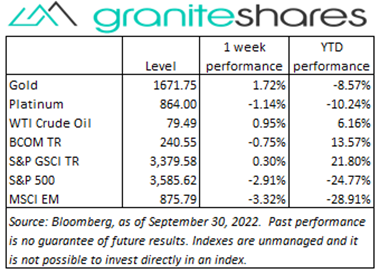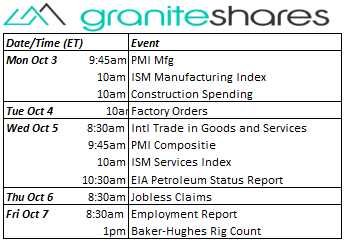Commodities & Precious Metals Weekly Report: Sep 30
Posted:
Key points
 Energy prices were mostly higher last week. WTI Crude oil prices increased 1%, heating oil prices 2% and gasoline prices 3%. Brent crude oil prices ended marginally lower and natural gas prices fell 3%.
Energy prices were mostly higher last week. WTI Crude oil prices increased 1%, heating oil prices 2% and gasoline prices 3%. Brent crude oil prices ended marginally lower and natural gas prices fell 3%.- Grain prices were mixed. Wheat prices were up over 4%, corn prices edged slightly higher and soybean prices fell over 4%.
- Precious metal prices were higher. Spot gold, silver and platinum prices increased 1%.
- Base metal prices were mixed. Copper prices moved 2% higher. Aluminum and zinc prices decreased about ½ percent. Nickel prices dropped 10%.
- The Bloomberg Commodity Index decreased 0.8%, primarily due to falling natural gas, base metal and soybean prices. The precious metals sector was the only positive performing sector.
- $1.5 billion outflows last week almost all from gold (-$1,042m) and broad commodity (-$382) ETPs. No ETP sector had inflows last week.
Commentary
 All 3 major stock indexes moved lower again last week falling between 2.5% and 3% ending lower on the week, month and quarter. Persistent hawkish comments by Fed and other central bank officials combined with stubbornly high levels of inflation in Europe and the U.S. increased fears of a central bank-induced global recession dragging stock and bond prices lower. Sharply higher U.K government bond yields and a plunging British pound (versus the U.S. dollar) precipitated by the UK government’s plans to increase spending while at the same time reducing taxes dragged U.S. markets lower as investors grappled with the possiblility of a UK financial crisis. Wednesday’s intervention by the BoE saying they would buy gilts no matter the amount, moved UK government bond yields lower and strengthened the British pound and, in the process, propelled US stock markets markedly higher. US stock indexes, however, fell over the remainder of the week with investors re-focusing on recession concerns. Weaker-than-expected durable goods orders and data showing home prices increasing at a sharply lower rate seemingly substantiated slowing growth while a slightly higher-than-expected core PCE Index release and lower-than-expected jobless claims supported the case for continued aggressive Fed tightening. The 10-year U.S. Treasury rate rose 14bps over the week but with falling 10-year inflation expectations. 10-year inflation expectation fell 11bps to 2.26% while 10-year real rates rose 25bps to 1.57%. The U.S. dollar moved off its recent highs with the DXY Index falling just under 1%. At week’s end, the S&P 500 Index lost 2.9% to close at 3,585.62, the Nasdaq Composite Index fell 2.7% to 10,575.62, the Dow Jones Industrial Average dropped 2.9% to 28,730.12, the 10-year U.S. Treasury rate rose 14bps to 3.82% and the U.S. dollar (as measured by the ICE U.S. Dollar index - DXY) weakened 0.9%.
All 3 major stock indexes moved lower again last week falling between 2.5% and 3% ending lower on the week, month and quarter. Persistent hawkish comments by Fed and other central bank officials combined with stubbornly high levels of inflation in Europe and the U.S. increased fears of a central bank-induced global recession dragging stock and bond prices lower. Sharply higher U.K government bond yields and a plunging British pound (versus the U.S. dollar) precipitated by the UK government’s plans to increase spending while at the same time reducing taxes dragged U.S. markets lower as investors grappled with the possiblility of a UK financial crisis. Wednesday’s intervention by the BoE saying they would buy gilts no matter the amount, moved UK government bond yields lower and strengthened the British pound and, in the process, propelled US stock markets markedly higher. US stock indexes, however, fell over the remainder of the week with investors re-focusing on recession concerns. Weaker-than-expected durable goods orders and data showing home prices increasing at a sharply lower rate seemingly substantiated slowing growth while a slightly higher-than-expected core PCE Index release and lower-than-expected jobless claims supported the case for continued aggressive Fed tightening. The 10-year U.S. Treasury rate rose 14bps over the week but with falling 10-year inflation expectations. 10-year inflation expectation fell 11bps to 2.26% while 10-year real rates rose 25bps to 1.57%. The U.S. dollar moved off its recent highs with the DXY Index falling just under 1%. At week’s end, the S&P 500 Index lost 2.9% to close at 3,585.62, the Nasdaq Composite Index fell 2.7% to 10,575.62, the Dow Jones Industrial Average dropped 2.9% to 28,730.12, the 10-year U.S. Treasury rate rose 14bps to 3.82% and the U.S. dollar (as measured by the ICE U.S. Dollar index - DXY) weakened 0.9%.
Up over 4% through Wednesday on a weaker U.S. dollar, lower-than-expected oil, gasoline and distillate inventory levels and Gulf of Mexico production cutbacks due to Hurricane Ian, WTI crude oil prices fell Thursday and Friday to finish the week up 1%. Prices fell Thursday and Friday as the U.S. dollar rebounded, the threat of Hurricane Ian diminished and over uncertainty regarding OPEC+ production cutbacks. Natural gas prices moved lower over the week despite production cutbacks due to Hurricane Ian with Hurricane Ian-related power outages and increasing storage levels pressuring prices lower.
Gold and silver prices moved higher last week supported both by a weaker U.S. dollar and increased haven demand. Wednesday’s BoE intervention to stem the fall in longer-dated UK government bond prices increased concerns of a brewing UK financial crisis, potentially increasing demand for gold and silver as a haven investment as did Russia’s annexing of occupied Ukraine territories.
Metal prices were mixed last week with copper prices rising and zinc, aluminum and nickel prices falling. Copper prices benefited from tight Chinese inventory levels and a weaker U.S. dollar. Nickel prices, down over 9% on the week, suffered from increased Indonesian supply and forecasts of sharply falling European demand.
Wheat prices, up almost 5% for the week, were boosted by potential export disruptions from the Black Sea regio due to recent developments in the Russia-Ukraine war, Russian harvest limitations resulting from the conscription of farmers as well as drought conditions in the U.S. limiting winter wheat crop planting. The price increase comes despite forecasts of a bumper Russian wheat crop. Corn price, down about 1% through Thursday, ended the week slightly higher after the USDA grain stocks report Friday showed lower-than-expected inventory levels. Soybean prices, also down about 1% through Thursday, dropped over 3% Friday following much larger-than-expected inventory levels in the USDA grains stock report.
Coming up this week
 A week defined by purchasing managers index releases and the employment report Friday.
A week defined by purchasing managers index releases and the employment report Friday.- PMI Mfg, ISM Mfg Index and Construction Spending on Monday.
- Factor Orders on Tuesday.
- Intl Trade in Goods and Services, PMI Composite and ISM Services Index on Wednesday.
- Jobless Claims on Thursday.
- Employment Report on Friday.
- EIA Petroleum Status Report Wednesday and Baker-Hughes Rig Count on Friday.

Who is Jeff Klearman in our research team? Jeff has over 20 years experience working as a trader, structurer, marketer and researcher. Most recently, Jeff was the Chief Investment Officer for Rich Investment Services, a company which created, listed and managed ETFs. Prior to Rich Investment Services, Jeff headed the New York Commodities Structuring desk at Deutsche Bank AG. From 2004 to 2007, he headed the marketing and structuring effort for rates based structured products at BNP Paribas in New York. He worked at AIG Financial Products from 1994 to 2004 trading rates-based volatility products as well as marketing and structuring. Jeff received his MBA in Finance from NYU Stern School of Business and his Bachelors of Science in Chemical Engineering from Purdue University.

